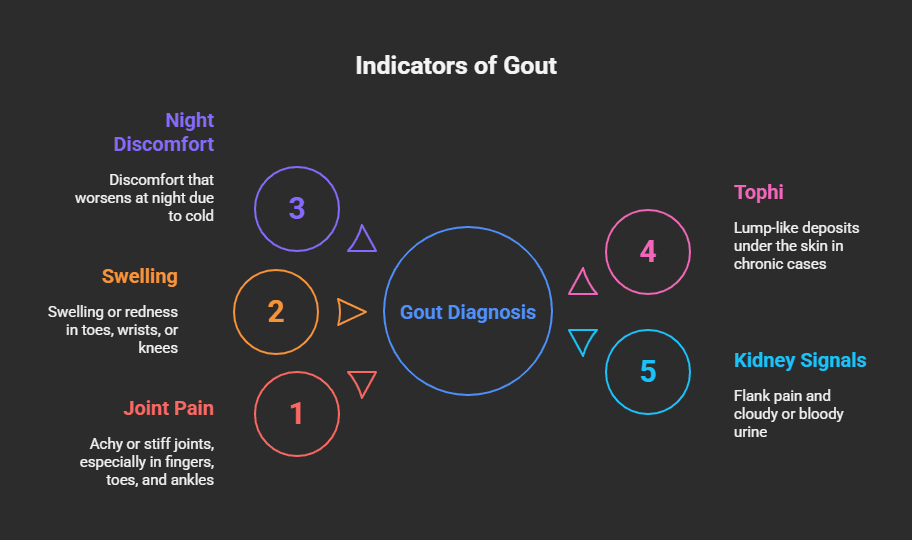Yes, it’s more than just a weird chemistry term your doctor mentions. It’s a tiny molecular player that can stir up big trouble if ignored. Ready to dive in? Good. Let’s go.
What Even Is Uric Acid?
Uric acid is the end product of purines, tiny compounds in your DNA and in many foods. Your liver, doing its chef thing with the enzyme xanthine oxidase, turns purines into uric acid. Then your kidneys handle cleanup, expelling about two‑thirds through urine; the rest heads out via stool. Normally, it’s a backstage waste product. But cluttered backstage? Then things go sideways.
Why It Gets Messy: Causes of High Uric Acid
Your uric acid levels can spike for a few key reasons, sometimes in clusters, like bad party guests who won’t leave.
Overproduction
- Eating purine‑rich fare, red meat, organ meats, shellfish, and beer? Your body runs on fizz.
- Rapid cell breakdown (like during chemotherapy) floods your system with purines.
Under‑Excretion
- Kidneys are not pulling their weight, common in kidney disease or from hypertension.
- Certain meds (diuretics, aspirin, niacin) can hamper uric acid clearance.
- High-fructose diets, those sodas, sugary syrups, they jam the exit.
Combo of Both
Usually, it’s diet plus genetics, or kidney stress paired with meds. Add obesity, diabetes, or high blood pressure to the mix, and you’re deep in hyperuricemia territory.
The Consequences: Why You Should Care
Gout
- That sudden, excruciating pain, often in the big toe, hits at night.
- Caused by needle‑like crystals settling in joints, the immune system freaks, and inflammation ensues.
- Repeated episodes can scar joints and form tophi (hard crystal deposits).
Kidney Stones & Damage
- Uric acid can crystallize in your urinary tract, causing severe pain, blood in the urine, and maybe nausea.
- Prolonged high levels can impair the kidneys, leading to a feedback loop of worsening excretion.
Metabolic & Heart Risks
- Hyperuricemia often tags along with insulin resistance, fatty liver, hypertension, and heart disease.
- While uric acid is an antioxidant in moderate amounts, once excessive, its role flips.
Signs It’s Becoming a Problem

Many people stroll into trouble with zero warning. But some signs might tip you off:
- Achy or stiff joints, especially fingers, toes, and ankles.
- Swelling or redness (toe, wrist, knee…).
- Night‑time discomfort, crystals love cold.
- Lump-like tophi under the skin (in chronic cases).
- Kidney‑related signals, flank pain, cloudy or bloody urine.
What’s Happening Inside: Your Body’s Balancing Act

- Purine → Xanthine → Uric Acid via xanthine oxidase in your liver.
- Exit routes: kidneys (~66%) and intestine (~33%).
- No uricase in humans, unlike many other mammals, so we can’t convert uric acid into a more soluble form.
- When kidneys fail, uric acid piles up.
- A healthy gut microbiome helps break it down; antibiotics or GI issues can disrupt that.
How Doctors Diagnose It
- Blood test: Anything over ~6.8 mg/dL is flagged; under 6 mg/dL is ideal for managing gout.
- 24‑hour urine test: Checks uric acid clearance.
- Joint fluid analysis: Crystal confirmation during flares.
- Imaging (ultrasound/CT/X‑ray): Reveals crystals, tophi, and damage.
Fix It (Yes, You Can!)
Lifestyle Wins
- Cut back on meat, shellfish, sugary drinks, and alcohol.
- Hydrate, stay ahead of crystal formation.
- Drop excess weight, each kg counts.
- Stick with gentle exercise, walking, swimming, and cycling.
Helpful Foods & Drinks
- Low‑fat dairy, vitamin C, coffee, and cherries show promising clearance benefits.
- Skip organ meats, fatty dairy, refined carbs, sweet drinks, and booze.
Medications (When Needed)
- For flares: NSAIDs, colchicine, steroids.
- Long‑term: Allopurinol, febuxostat (cut production); probenecid (boost excretion).
- Big tophi or stones: Surgery or specialty meds like rasburicase (in tumor lysis).
- Kidney stones may require urine alkalinization.
Final Thoughts
Uric acid isn’t just about painful flare-ups; it’s a window into your metabolic and renal health. Keep levels in check, and you can avoid joint damage, kidney stones, and broader metabolic risks.
What You Can Do Today:
- Get tested, a simple blood draw shows a lot.
- Track triggers, note what you eat, and how you feel.
- Make smart swaps, water instead of soda, lean protein over red meat, and daily walks.
- Chat with your doctor, especially if you’re dealing with flares, lumps, stones, or chronic conditions.
Many folks manage their uric acid by transforming their lifestyle, not relying on meds forever. And when medication is needed, it’s part of a plan that keeps everything balanced.
Rapid Snapshot
- Origins: Purine breakdown in the liver.
- Exit: Kidneys and gut.
- High levels = gout, stones, metabolic issues.
- Fix: Diet, hydration, weight management, meds when needed.
A Friendly Close
So, next time you grab that soda, pile on shrimp, or binge on fast food, pause for a sec. Your body’s working (whether you notice it or not). And keeping uric acid cool? It’s about more than toe pain. It’s about your future, healthier joints, stronger kidneys, and a sharper metabolic profile. You’ve got this.








